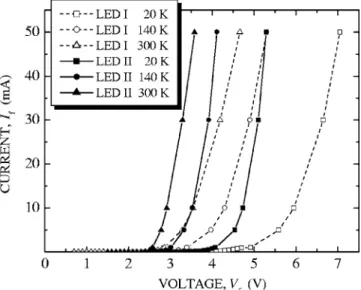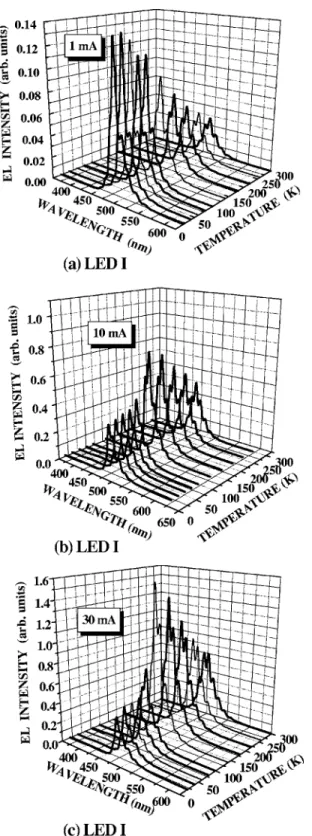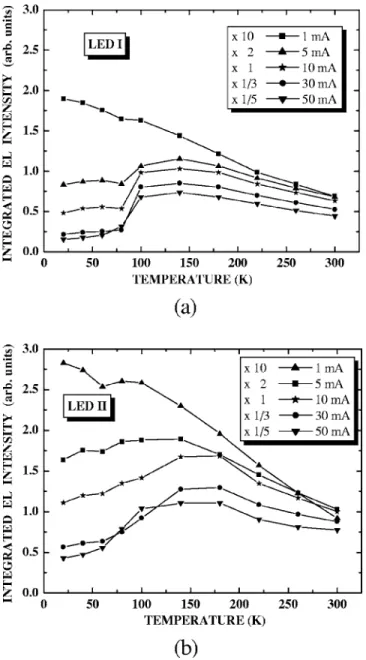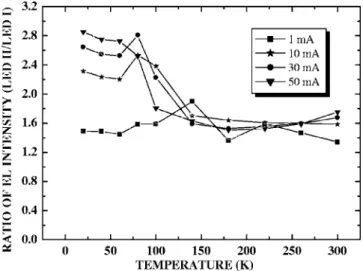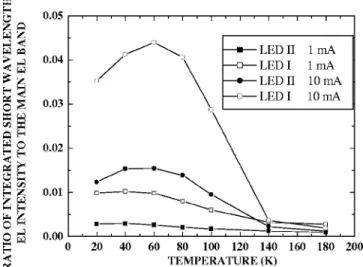Kitakyushu 804-8550, Japan J. K. Sheu
Institute of Electro-Optical Science and Engineering, National Cheng-Kung University, Tainan 701, Taiwan
共Received 4 July 2006; accepted 16 September 2006; published online 5 December 2006兲 The temperature dependence of the electroluminescence 共EL兲 spectral intensity has been investigated in detail between T = 20 and 300 K at various injection current levels for a set of two blue InGaN / GaN multiple-quantum-well共MQW兲 light-emitting diodes 共LEDs兲 with and without an additional n-doped In0.18Ga0.82N electron reservoir layer 共ERL兲. The radiative recombination efficiency of the main blue emission band共⬃480 nm兲 is found to be significantly improved at all temperature regions and current levels when the additional ERL is introduced. For high injection currents If, i.e., large forward bias voltages Vf, a quenching of the EL intensity is observed for T
⬍100 K for both LED structures, accompanying appearance of short-wavelength satellite emissions around 380– 430 nm. Furthermore, the low-temperature intensity reduction of the main EL band is stronger for the LED without the ERL than with the ERL. For low If, i.e., small Vf, however, no quenching of the EL intensity is observed for both LEDs even below 100 K and the short-wavelength satellite emissions are significantly reduced. These results of the main blue emission and the short-wavelength satellite bands imply that the unusual evolution of the EL intensity with temperature and current is caused by variations of the actual potential field distribution due to both internal and external fields. They significantly influence the carrier capture efficiency by radiative recombination centers within the active MQW layer and the carrier escape out of the active regions into high-energy recombination centers responsible for the short-wavelength satellite emissions. © 2006 American Institute of Physics.
关DOI:10.1063/1.2398690兴
I. INTRODUCTION
Despite the great success of blue and green light- emitting diodes共LEDs兲 based on InGaN quantum-well 共QW兲 heterostructures, the origin of the very bright emission char- acteristics is still controversially discussed.1–10 A peculiar property of this material system is the observation of effi- cient luminescence at room temperature, although the den- sity of misfit dislocations can be as high as 1010cm−2due to the large lattice mismatch between the InGaN / GaN epitaxial layers and the sapphire substrate. Therefore, we expect the existence of a particular mechanism, which is responsible for the enhancement of the radiative efficiency in the presence of a high defect density. Previous studies of the temperature- dependent electroluminescence 共EL兲 spectral intensity in single-QW共SQW兲 diodes7,8show that efficient capture pro- cesses of injected carriers by localized tail states within the SQW layer play an important role for the recombination ef- ficiency between T = 180 and 300 K. However, for T
⬍100 K, an anomalous quenching of the EL intensity is ob- served, which we attribute to a reduction of the vertical car- rier capture rates.7We have also investigated the temperature dependence of the EL intensity for a specially designed blue
InGaN / GaN multiple-QW共MQW兲 LED containing an addi- tional n-doped InGaN electron reservoir layer共ERL兲.11This LED exhibits a significant improvement of the radiative ef- ficiency in comparison with the LED without the ERL. In relation to the high luminescence efficiency under the pres- ence of the high defect density in InGaN MQWs, Hangleiter et al.12and Hitzel et al.13recently proposed that most of the defects in the active region can be decorated by the higher band gap materials thus blocking the carriers to be nonradia- tively extinguished, leading to the improved radiative recom- bination in spite of the existence of high defect density. This lateral carrier blocking mechanism against defect trapping within the active quantum-well layer is involved with the emissions at short-wavelength regions. Therefore, it is inter- esting to seek for whether the short-wavelength satellite emissions are correlated with the main EL band when the radiative recombination efficiency is significantly changed as a function of temperature and bias due to the changes of carrier capture efficiency by the radiative recombination cen- ters.
In this paper, we report on a detailed investigation of the EL intensity of InGaN / GaN LEDs with and without the ERL as a function of temperature and injection current level to study how the carrier capture efficiency varies with bias con- ditions. By comparing the temperature-dependent EL charac-
a兲FAX:⫹81-93-884-0879; electronic mail: fujiwara@ele.kyutech.ac.jp
0021-8979/2006/100共11兲/113105/7/$23.00 100, 113105-1 © 2006 American Institute of Physics
teristics of the two MQW-LEDs for low and high injection currents over a wide spectral range, the enhanced EL effi- ciency observed in the MQW-LED with the ERL is attributed to an improved electron capture by radiative recombination centers. This capture is significantly influenced by the ap- plied forward bias conditions 共external field effects兲. Good correlation between the main EL efficiency and the short- wavelength satellite emission band is obtained.
II. EXPERIMENT
A set of two InGaN / GaN MQW-LEDs without and with an additional n-doped In0.18Ga0.82N electron reservoir layer 共ERL兲, named LED I and LED II, respectively, were grown by metal-organic vapor-phase epitaxy.14A schematic layered structure of the LEDs is shown in Fig.1. The emission re- gion of the LEDs consists of a triple In0.3Ga0.7N QW with a nominal width of 2.5 nm separated by 6.5 nm GaN barriers.
This MQW layer is clad by 4 m n-GaN and 30 nm p -Al0.15Ga0.85N layers. A 15-nm-thick n-doped 共⬃1019cm−3兲 In0.18Ga0.82N ERL is located between the n-GaN clad and the active MQW layer. A thickness of n-doped GaN barrier be- tween the ERL and the active layer is thinned to be 3 nm.
The p-i-n diode is formed by forming metal contacts on 0.25m p-GaN cap layer and the n-GaN clad layer laterally.14 Thus, in this set of two diodes 共LED I and II兲, only the addition of the ERL between the active MQW and the n-GaN barrier layers is different. EL spectra of the MQW-LEDs mounted on a Cu cold stage of a closed-cycle He cryostat were recorded for the dominating blue MQW emission band as well as for high-energy bands from other layers by conventional lock-in detection techniques at tem- peratures between 20 and 300 K as a function of the injected current between 1.0 and 50 mA.
III. RESULTS AND DISCUSSION
The current-voltage共If-Vf兲 characteristics of LEDs I and II have been measured between T = 20 and 300 K. Figure 2 shows representative If-Vfcurves at 20, 140, and 300 K. At 300 K, a typical Vfvalue for If= 10 mA for LED II is 2.9 V, while for LED I the corresponding value of Vf is 3.6 V, so that a smaller Vfis necessary to achieve the same value of If
for LED II with the ERL than for LED I without the ERL.
That is, the forward bias voltage to get a certain current level is significantly reduced for LED II. This means that the stan-
dard Shockley recombination theory15 needs to be modified by the additional heterostructure configuration. When the lat- tice temperature is decreased to 20 K, the If-Vf characteris- tics also change significantly, and the forward bias to obtain a current level increases substantially probably due to the reduced density of holes because of trapping by the deep Mg accepter level. That is, there are fewer holes in the p-type region at lower temperatures than at room temperature. At 20 K, the difference between the values of Vf for the two LEDs becomes even larger. When the temperature is de- creased from 300 to 20 K in Fig. 2, the forward bias to achieve a sufficient current level, say 10 mA, is increased by about 2 – 3 V in both LEDs. This increase of the forward bias with decreasing temperature is most probably due to the re- duced hole conductivity in the p-GaN and p-共Al,Ga兲N lay- ers at lower temperatures. In addition, we find a clear differ- ence in the slope of the logarithm of If as a function of Vf
between the two samples as well as between room and low temperatures 共not shown here兲. Further investigations are necessary to fully understand the observed temperature de- pendence of the If-Vf characteristics and the different behav- iors of the two LEDs. It should be noted, however, that the trapping of holes at 20 K due to the deep Mg accepter level 共⬃170 meV兲 in p-GaN cannot explain all the observed
FIG. 1. 共Color online兲 Schematic layered structure of the InGaN / GaN MQW-LEDs without共LED I兲 and with an additional n-type In0.18Ga0.82N ERL共LED II兲.
FIG. 2. If-Vfcurves at 20, 140, and 300 K of the InGaN / GaN MQW-LEDs without共LED I: open symbols兲 and with an additional n-type In0.18Ga0.82N ERL共LED II: full symbols兲.
changes between LED I and LED II, since the p-GaN and p-共Al,Ga兲N layers 共with hole concentrations of ⬃1017cm−3兲 are nominally identical in both samples. Here, we would like to emphasize that the addition of a wide n-In0.18Ga0.82N layer between the n-GaN barrier and the MQW layer has a signifi- cant impact on the If-Vfcharacteristics, i.e., it reduces Vffor a particular value of If.
Figure3shows EL spectra of LED I without the ERL as a function of temperature at three injection current levels:共a兲
peak intensity decreases as the temperature is increased. This decrease of the EL intensity with increasing the temperature is ascribed to an enhancement of nonradiative recombination processes, i.e., a reduction of the radiative recombination ef- ficiency. When the current level is increased, however, the temperature dependence of the EL intensity is drastically changed, as illustrated in Figs.3共b兲and3共c兲. A reduction of the EL intensity is clearly seen with decreasing the tempera- ture below 100 K after reaching the maximum EL intensity around 140 K. At 30 mA关Fig.3共c兲兴 the EL intensity reduc- tion is significant at 20 K and the difference in EL intensity between 140 and 20 K becomes larger than at 10 mA 关Fig.
3共b兲兴. The similar temperature dependence of EL spectra is plotted in Fig.4for LED II with the ERL. At 1.0 mA关shown in Fig.4共a兲兴 the EL intensity observed as a function of tem- perature shows the similar behavior as the LED I, that is, the reduction of EL intensity with increasing the temperature.
The maximum of the spectrally integrated EL intensity is reached at 20 K in Fig.4共a兲. This enhancement of the radia- tive recombination efficiency around 20 K is commonly ob- served for both types of LEDs, which is similar to the pho- toluminescence 共PL兲 efficiency enhancement observed at low temperatures due to the reduced nonradiative recombination.5,10 However, it is important to note that the absolute EL intensity for LED II becomes larger than that for LED I for all temperatures共note the ordinate scale change兲.
When the injection current level is increased to 10 mA, the difference in EL temperature dependence between LED I and LED II becomes even larger. That is, the EL reduction with decreasing temperature is strongly suppressed at 10 and 30 mA in Figs.4共b兲and4共c兲in comparison with Figs. 3共b兲 and3共c兲. The LED II with the ERL always shows a stronger EL intensity than LED I without the ERL, in agreement with our previous results.11,14
In order to further investigate the origin of the reduced EL efficiency at lower temperatures and higher injection lev- els, we have also evaluated the spectrally integrated EL in- tensity divided by the current, that is, the EL external quan- tum efficiency as a function of temperature for different injection current levels. Figures5共a兲and5共b兲show the inte- grated EL intensity as a function of temperature at various current levels from 1.0 to 50 mA共normalized to the case of 10 mA兲 for LED I and LED II, respectively. For If
= 1.0 mA, the EL efficiency exhibits its highest value at 20 K, which monotonously decreases with increasing tem- perature in both cases. When the injection level is increased to 10 mA, the EL efficiency per injection current decreases in comparison with the case of If= 1.0 mA. Note that the EL efficiency effectively decreases with increasing current level up to 50 mA for both LEDs. Therefore, we conclude that the reduction of Vf for LED II in comparison with LED I 共cf.
Fig.2兲 plays an important role in the enhancement of the EL efficiency at 20 K. We emphasize that the EL efficiency per injected carrier is highest at the lowest current of 1.0 mA at
FIG. 3. Temperature-dependent EL spectra of LED I without an additional ERL for共a兲 If= 1 mA,共b兲 10 mA, and 共c兲 30 mA.
all temperatures in Fig. 5 for both of the diodes. It appears that the carriers are effectively captured by active centers in the MQW under the application of lower forward biases.
But, applying higher forward biases, they are rather trans- ferred to nonradiative recombination centers as a result of escape from the MQW region, thus reducing the EL effi- ciency. This is because the carriers can escape out of the well region due to the internal field effects, since the junction field
direction is opposite to the internal field. We also note that the higher field existing in the well under the higher forward bias decreases the radiative recombination rate due to the quantum-confined Stark effect, which also causes the re- duced EL intensity.
In Fig.5, it is noted that the difference in the EL inten- sity between the two LEDs becomes even larger at 20 K for If= 30 mA than for If= 1.0 mA 共cf. also Figs.3 and4兲. The difference of a factor of about 2 is seen between the EL intensities in Figs.3共a兲and4共a兲as well as in Figs.3共c兲and 4共c兲. For If= 1.0 mA the ratio of the EL intensities of LED II to LED I is approximately temperature independent. But it strongly increases with decreasing temperature for If
= 30 mA. In order to demonstrate this difference more clearly, the ratio of the integrated EL intensity of LED II to LED I is plotted in Fig.6for If= 1.0, 10, 30, and 50 mA as a function of temperature. Note that the EL intensity of LED II is always stronger than that of LED I, irrespective of tem- perature and current level. Furthermore, the enhancement of
FIG. 4. Temperature-dependent EL spectra of LED II with an additional ERL for共a兲 If= 1 mA,共b兲 10 mA, and 共c兲 30 mA.
FIG. 5. Temperature dependence of integrated EL intensity of共a兲 LED I without and共b兲 LED II with an additional ERL for If= 1, 10, 30, and 50 mA.
the EL efficiency with decreasing temperature 共around 20– 80 K兲 is significant for LED II over LED I. The im- provement of the EL efficiency for LED II with the ERL is, in fact, remarkable, indicating the importance of the carrier escape processes from radiative recombination centers in the InGaN MQW layer under the presence of higher forward biases.
In order to verify the carrier escape from the active MQW layer to the barrier regions, we have measured short- wavelength EL spectra around 360– 450 nm below the lead- ing blue共⬃480 nm兲 EL band including the spectral regions of the barrier materials and the ERL. The results are shown in Fig.7for LED I关共a兲 and 共b兲兴 and for LED II 关共c兲 and 共d兲兴 at low共1.0 mA兲 and high 共10 mA兲 currents, respectively. In Fig. 7共a兲 for LED I and at 1.0 mA, more than 100 times weaker emissions are seen at short-wavelength regions 关peaked around 420 nm 共2.95 eV兲兴 than the main blue 共
⬃480 nm兲 band. The intensity of the satellite EL band mo- notonously increases with decreasing temperature, while the main EL band shows appreciable increases in intensity at 1.0 mA. Therefore, the results in Fig. 7共a兲are explained by the fact that the EL efficiency is basically determined by the internal quantum efficiency due to the reduced nonradiative recombination processes. When the current is increased to 10 mA in Fig. 7共b兲, however, the EL intensity of satellite emissions drastically increases by almost one order of the magnitude relative to the main band and more rapidly in- creases when decreasing temperatures below 100 K. The EL efficiency of the main blue band thus decreases at 20 K when the current increases, as indicated in Fig.5共a兲. That is, the main EL peak intensity decreases at temperatures below 140 K when the current is higher than 10 mA. On the other hand, as shown in Figs.7共c兲and7共d兲, the short-wavelength satellite band of LED II is found to be much weaker than that of LED I. Enhancement of the satellite emission with in- creasing the current to 10 mA is not so significant in Fig.
7共d兲, indicating the improved carrier capture efficiency by the active region. This result is consistent with the improved radiative recombination efficiency in Figs.4共b兲and4共c兲, es-
pecially at lower temperatures. But it is worth to note that the satellite EL emission also rapidly increases below 100 K in Fig.7共d兲 in a similar way as in Fig.7共b兲.
Figure 8 shows the satellite EL emission efficiency by
FIG. 6. Temperature dependence of ratio of integrated EL intensity共LED II/LED I兲 for If= 1, 10, 30, and 50 mA.
FIG. 7. Short-wavelength EL spectra of关共a兲 and 共b兲兴 LED I without and 关共c兲 and共d兲兴 LED II with an additional ERL for If= 1 and 10 mA, respectively.
plotting ratio of the integrated short-wavelength EL intensity divided by the integrated main EL intensity for LED I and II at low共1.0 mA兲 and high 共10 mA兲 current levels as a func- tion of temperature. For the injection current of 10 mA the short-wavelength emission efficiency of LED I is, in fact, increased at lower temperatures共below 100 K兲, indicating a reduction in the carrier capture rates by the MQW layer.11 For LED II this increase of the satellite emission at 10 mA is significantly reduced and therefore the EL efficiency is im- proved due to the increased carrier capture efficiency. We note in Figs.7and8that, as the temperature goes down to 20 from 60 K, the short-wavelength satellite EL intensity slightly decreases. This is especially true for the injection current of 10 mA, while the main EL band is decreasing. We attribute these simultaneous intensity decreases of the main and satellite EL bands at 20 K to the reduction of the carrier injection efficiency from the clad layers into the active/
barrier regions due to the decreased carrier mobility 共most probably due to the decreased hole mobility兲.
In Fig.7the broad satellite EL band at short wavelengths around 370– 430 nm共2.88–3.35 eV兲 is definitely enhanced under the higher forward bias conditions. It is important and interesting to inquire what the origin of this broad EL band is and whether the satellite band is related to the short- wavelength PL band共3.0–3.3 eV兲 observed by Hitzel et al.13 for the high-band-gap material, effective as the carrier block- ing layer against defect trapping. In our analysis the EL ef- ficiency of the satellite band, which sensitively changes with bias and temperature, is simply used as a measure for the carrier escape out of the active regions in the MQW layer.
Since our observation shows that the satellite EL band is significantly suppressed by the addition of ERL, electrons injected from the n-type ERL are more efficiently captured into the active regions under the forward bias conditions.
This is because the band gap energy of the ERL material 共estimated to be ⬃3.06 eV by a sharp PL peak observed兲 is lower than the GaN barriers 共3.5 eV兲, so that the carrier overshoot is suppressed, thus enhancing the main blue EL band. One possibility for those overshooting electrons with-
out the ERL is that they are to be captured in the p-GaN cap layer. Thus, the satellite emissions might be due to the donor- acceptor 共D-A兲 pairs in the p-GaN cap layer. However, the broad共the bandwidth ⬃0.47 eV兲 satellite emission band and the large Stokes shifts共0.15–0.62 eV兲 observed are not con- sistent with the D-A recombination, as pointed out by Yang et al.10As a matter of fact, the satellite EL band is enhanced with increasing the forward bias and without the ERL. So, this emission band should not be related to the InGaN alloy fluctuations in the well layers共because the alloy effects are the same for both samples兲, but rather related to the barrier GaN layers. It is interesting to point out that the thinner sidewall quantum well as observed by transmission electron microscope12 may also contribute to the stronger radiative recombination at the short-wavelength EL band. The ob- served broad linewidth for the satellite EL band may be ex- plained if we take the quantum-confined Stark effect共QCSE兲 due to the internal field under the forward bias into account.
However, more work is obviously necessary to elucidate the detailed carrier escape mechanisms under the forward bias conditions. Nevertheless, it is clear that the carrier capture by the MQW active regions is significantly improved by the additional ERL and by reducing the forward bias voltage, thus enhancing the EL efficiency by current injection.
IV. CONCLUSION
The EL spectral intensity of the main blue and the short- wavelength satellite bands has been investigated as a func- tion of temperature and injection current for a set of two In0.3Ga0.7N / GaN triple-quantum-well light-emitting diodes without and with an additional n-doped In0.18Ga0.82N elec- tron reservoir layer. We find that the temperature variation of the EL efficiency critically depends on the injection current level and the presence of the additional ERL. For low current levels and thus small forward bias voltages, EL quenching does not occur below 100 K due to efficient carrier capture, as evidenced by the reduced satellite EL band. However, for high injection current levels and thus large forward bias volt- ages, the EL quenching persists below 100 K, and its tem- perature variation is more pronounced in the LED without the ERL. This unique temperature dependence of the EL intensity variation at different injection levels originates from the difference in the forward bias voltage. Appearance of the short-wavelength satellite band when the main blue emission band is reduced is consistent with the EL mecha- nism by Hangleiter et al.12 and Hitzed et al.13These results imply that the unusual evolution of the EL efficiency with current level and temperature can be caused by variations of the potential field distribution due to both internal and exter- nal fields, which significantly influence the carrier capture efficiency within the MQW active layer.
ACKNOWLEDGMENTS
The authors would like to thank H. Kostial, U. Jahn, and H. T. Grahn of Paul-Drude Institute for Solid State Electron- ics in Berlin, Germany for sample wiring and useful discus- sion. They also thank Y. Takahashi, H. Katou, and A. Satake for their experimental assistance. This work was supported in
FIG. 8. Temperature dependence of ratio of the integrated short-wavelength EL intensity to the main EL band of LED I without and LED II with an additional ERL for If= 1 and 10 mA.
lin, 1997兲.
2S. Nakamura, M. Senoh, N. Iwasa, S. Nagahama, T. Yamada, and T. Mu- kai, Jpn. J. Appl. Phys., Part 2 34, L1332共1995兲.
3T. Takeuchi, S. Sota, M. Katsuragawa, M. Komori, H. Takeuchi, H.
Amano, and I. Akasaki, Jpn. J. Appl. Phys., Part 2 36, L382共1997兲.
4T. Mukai, K. Takekawa, and S. Nakamura, Jpn. J. Appl. Phys., Part 2 37, L839共1998兲.
5Y. Narukawa, Y. Kawakami, S. Fujita, and S. Nakamura, Phys. Rev. B 59, 10283共1999兲.
6K. P. O’Donnell, R. W. Martin, and P. G. Middleton, Phys. Rev. Lett. 82, 237共1999兲.
10C. L. Yang et al., J. Appl. Phys. 98, 23703共2005兲.
11Y. Takahashi, A. Satake, K. Fujiwara, J. K. Sheu, U. Jahn, H. Kostial, and H. T. Grahn, Physica E共Amsterdam兲 21, 876 共2004兲.
12A. Hangleiter, F. Hitzel, C. Netzel, D. Fuhrmann, U. Rossow, G. Ade, and P. Hinze, Phys. Rev. Lett. 95, 127402共2005兲.
13F. Hitzel, G. Klewer, S. Lahmann, U. Rossow, and A. Hangleiter, Phys.
Rev. B 72, 081309R共2005兲.
14J. K. Sheu, G. C. Chi, and M. J. Jou, IEEE Photonics Technol. Lett. 13, 1164共2001兲.
15E. Fred Schubert, Light-Emitting Diodes 共Cambridge University Press, Cambridge, UK, 2005兲.
